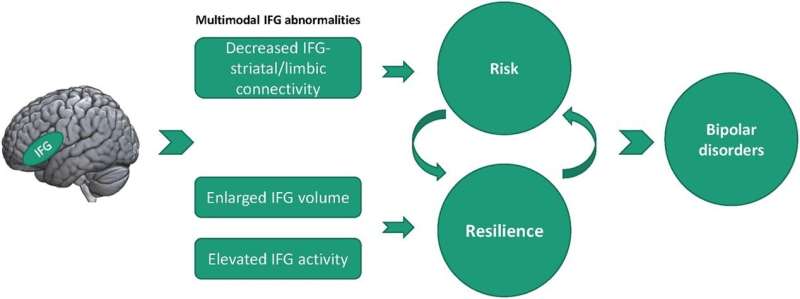This article has been reviewed according to Science X's editorial process and policies. Editors have highlighted the following attributes while ensuring the content's credibility:
fact-checked
proofread
Exploring the link between the inferior frontal gyrus and familial risk for bipolar disorder

Bipolar disorder, marked by recurrent manic and depressive episodes, poses significant social and economic challenges globally. With approximately 75% heritability in first-degree relatives, BD is a high-risk condition for those with family history.
The emergent field of psychoradiology, which focuses on the clinical application of neuroimaging in psychiatry, has allowed scientists to study subtle alterations in brain systems. This has led to the discovery of the IFG as a potential biomarker of genetic vulnerability for BD. The IFG, a brain region involved in cognitive control and emotional regulation, has been consistently linked to BD-risk mechanisms. Notably, even individuals at risk who remain psychiatrically well can exhibit brain abnormalities, pointing to the existence of risk and resilience factors.
The review, published in Psychoradiology, was conducted by researchers from West China Hospital of Sichuan University and University of Cincinnati College of Medicine. This review summarizes studies using magnetic resonance imaging (MRI) to assess multimodal IFG abnormalities in individuals with a familial risk for BD. The review suggests that these alterations may contribute to behavioral deficits, such as impulsivity, mood instability, inattention, and cognitive dysfunction.
The review highlights that at-risk individuals exhibit larger gray matter volume and increased functional activities in the IFG compared to their low-risk counterparts. This may be an adaptive brain response that aids emotional regulation, potentially acting as a resilience factor. However, the same at-risk individuals also exhibited diminished functional connectivity between the IFG and areas crucial for cognitive and emotional control, such as the limbic system or the striatum—a risk-associated concern.
Despite these advancements, significant inconsistencies remain across the findings, reflecting the need for more robust and systematic studies. The role of the IFG in genetic vulnerability for BD is becoming more apparent, but comprehension of this relationship is still in the early stages. To further understand the IFG's role in BD risk, large-scale, longitudinal studies that employ advanced imaging techniques are required.
More information: Kun Qin et al, The inferior frontal gyrus and familial risk for bipolar disorder, Psychoradiology (2022). DOI: 10.1093/psyrad/kkac022


















